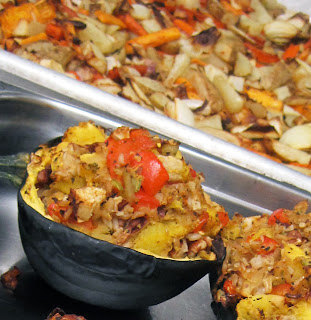In the Hub's Youth Garden Program, students will often harvest
& cook whole food snacks such as Kale chips or roasted beets,
parsnips and sweet potato.
Last Wednesday students from MHC’s youth garden program prepared
a meal using some of the sweet potatoes and kale they grew in the garden. As
they prepared the food we talked about the
differences between whole foods, minimally processed foods and overly processed
foods. The students were asked to figure out how many whole foods verses processed foods they used to prepare the meal. The hope was that students would
experience a tasty meal and recognize that eating whole foods actually tastes great. We asked the students why they
thought it was important to eat more whole foods (real food) and less
processed? The students soon began to share answers they had learned from
previous weeks, “whole foods have more nutrients in them,” “whole foods give
your body energy,” “our bodies work
harder to break down the processed foods,” and last, “processed food will not
give you energy that lasts, but whole food will.”
As the students sat down to enjoy the meal they had prepared
each student shared the things they were thankful for. Several students included garden club, the
garden and their worm bin to their list of thanksgivings.
The meal was a complete success! Everyone enjoyed all that
was prepared with the exception of one student who said he doesn’t like
anything that taste like tacos, but he liked everything else. Our meal consisted of Hummus Tacos, Sweet Potato Oven Fries, Kale chips and an Apple Oat Crisp for dessert.
Terms the students learned:
Whole foods = whole foods are foods in their natural state, or very close to their natural state. The vitamins, minerals and other nutrients remain intact in the food, and they do not typically contain added ingredients. Examples include fresh vegetables and fruits, beans, whole chicken, whole grains (such as oats and brown rice), eggs and milk.
Minimally processed foods = whole foods which have been changed
or added to in order to preserve naturally.
Examples include butter, whole grain bread,
plain yogurt, juice, cheese.
Overly processed foods = foods which have been changed a lot
from their original form before they are cooked, or foods that have added chemicals
or artificial ingredients.
Examples include mosts cereals and breads, crackers, frozen pizza, boxed
mac and cheese, fruit snacks, frozen prepared meals, fast foods.



